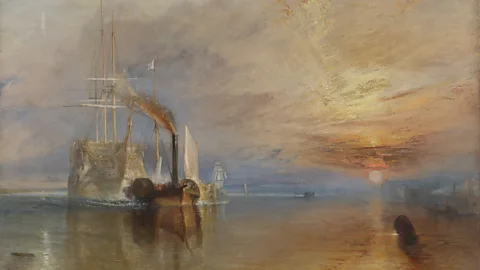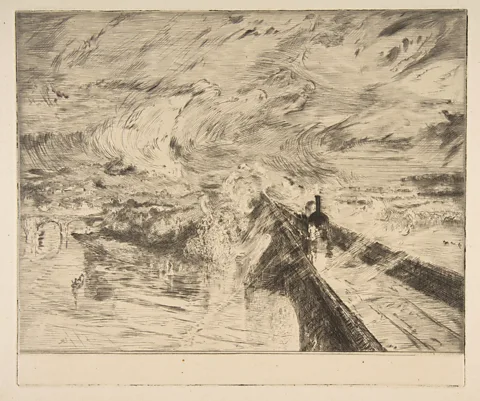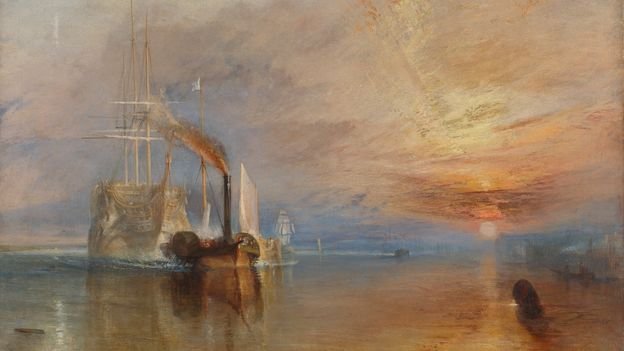 The National Gallery, London
The National Gallery, LondonAs museums around the world celebrate the 250th birthday of JMW Turner, it’s time to reappraise his beloved and celebrated painting, The Fighting Temeraire.
JMW Turner’s The Fighting Temeraire became a national celebrity when it was first unveiled in 1839, and its fame has endured to the present day. It was once voted Britain’s favourite painting and currently features on £20 banknotes. But the widely accepted interpretation of this iconic painting’s message might, in fact, contradict Turner’s true intentions.
The “Temeraire” of the title refers to a 98-gun warship of the British Navy, which is depicted in the painting’s background. It was a hero in Britain’s defence against France during the Napoleonic Wars, but it caught the nation’s attention in 1838 when it was dismantled and its parts sold off. Turner’s painting depicts this once-mighty gladiator of the seas being towed down a burnished River Thames by a much more recently invented steam-powered tugboat.
A brief segment in the 2012 James Bond film Skyfall captures a popular view about the painting. In the scene, Bond (Daniel Craig) meets Q (Ben Whishaw), his new head of research and development, in London’s National Gallery, and they sit in front of The Fighting Temeraire. “It always makes me feel a little melancholy”, says the young, tech-savvy Q, in a pointed jibe to 007, an old-school field agent. “A grand old warship being ignominiously hauled away for scrap.”
This echoes the widely held belief that the painting evokes a sense of nostalgia and faded national glory. According to this view, the ghostly Temeraire is the painting’s heroine, and the tugboat its villain. In the 19th Century, the English writer William Makepeace Thackeray referred to the smaller vessel as “a little, spiteful, diabolical steamer” and the American novelist Herman Melville called it “a pygmy steam-tug” by comparison to the “Titan Temeraire”.
 The National Gallery, London
The National Gallery, LondonYou can see why Turner’s original audience may have sympathised with the humbled HMS Temeraire and been saddened by her fate. Back in 1804, she had played a critical role in blockading French ports and defending the British coast. But her finest moment came on the afternoon of 21 October 1805, in the Atlantic Ocean, just off the coast of south-west Spain.
At this pivotal hour, the Battle of Trafalgar, a deadly sea battle between the British Royal Navy and the combined fleets of Spain and France, was at its climax. Admiral Lord Nelson’s flagship HMS Victory had led the attack but was being pummelled by the French vessel Redoubtable. Then, out of the cannon smoke, surged HMS Temeraire, followed by a war-hungry flotilla of British vessels. The Temeraire blasted the Redoubtable with her guns and endured a hailstorm of cannon volleys in return – an onslaught that lacerated the ship and spattered her decks with blood. But like a stalwart prize-fighter, the Temeraire weathered the bout. She valiantly protected her flagship and played a vital part in the British navy’s ultimate victory in the Battle of Trafalgar.
Finding beauty in newness
Turner was 64 when he painted The Fighting Temeraire. He was born in 1775 in a down-at-heel area of London near Covent Garden but managed to enrol at the prestigious Royal Academy of Arts aged 14. He became an Academician at the precocious age of 24, and a Professor of Perspective when he was just 32. But although he rubbed shoulders with the great and the good, he refused to soften his Cockney accent or refine his manners. He was also fiercely entrepreneurial – he opened his own private gallery, sought wealthy patrons, and was always on the lookout for captivating and lucrative new artistic projects that might have widespread appeal. On one level, The Fighting Temeraire achieves his desire for broad popularity by harnessing people’s sense of national pride.
But there’s an even more important message to learn from the painting than its patriotism and sentimentality. It concerns that much maligned tugboat: the true focal point of the painting.
Steam power was the new mechanical wonder of Turner’s age, and his attitude to this recent technology was much more complicated than Thackeray, Melville or Q recognised. In other Turner artworks, like Snow Storm – Steam-Boat (1842) and Rain, Steam and Speed (1844), you can see his fascination with modern machinery and its transformative influence on individual experience, the environment, and society as a whole. This is in stark contrast with Turner’s great rival John Constable, whose parents were from the elite, and whose paintings tended to overlook some of the most seismic changes that were reshaping the British Isles at the time.
In Constable’s iconic 1821 painting The Hay Wain, an archaic cart rolls gently away from the viewer into a bucolic English landscape. Turner’s The Fighting Temeraire gives us the exact opposite, putting the spectator on a collision course with the unstoppable force of industry.
 The National Gallery, London
The National Gallery, LondonThis reflected contemporary reality. At the time The Fighting Temeraire was painted, the Royal Navy was increasingly using steamboats for towing bigger vessels. Moves were already afoot to replace its sail-powered fleet with new steam frigates. But the demise of the Temeraire didn’t reflect a routine upgrade in armaments. This was a one-of-a-kind revolution in seafaring. Sailors around the world had relied on wind-and-sail or oar-propulsion for thousands of years. Now, steam engines could allow seafarers to overcome the vagaries of gusts, shallows and tidal patterns – to supersede nature itself. The future was steam-powered, but how this was going to affect the future of transport, trade and naval combat was still anybody’s guess in the 1830s. What Turner did know was that as far back as Homer’s Odyssey, sailing functioned as a profound symbol of the life journey in art and literature. And so, by hitching the old and the new so unforgettably in his painting, he shows us a compelling metamorphosis – the beginning of a new, post-industrial lifecycle in human history.
Turner was awake to the responsibility of artists in times of irreversible historical change. For him, the age-old skill of depicting wooden sailing ships, their rigging, sails and ornately carved figureheads was becoming obsolete. The challenge for every artist (and every member of society) in the modern age, he realised, was to discover beauty and significance in newness, and in artefacts that had not previously been depicted in art, like iron funnels, pistons, valves, and paddle wheels. In The Fighting Temeraire, his rise to this challenge is captured in a very memorable and uncompromising symbol.
Turner even adapted his painting technique to express the technological and social transformations in the world around him. He used newly invented paint hues like Lemon Yellow and Scarlet Lake in The Fighting Temeraire. Pigment analysis of the painting also indicates that he raided from his kitchen for substances to add his paint to achieve desired effects, like tallow, cooking fat or even salad oil.
His interest in new technology, and his search for innovative techniques with which to represent them, had a direct impact on the next generation of avant-garde painters. Claude Monet and Camille Pissarro were both wowed by Turner’s art. An engraving of Turner’s Rain, Steam and Speed (which depicts a train hurtling over Maidenhead bridge) was even displayed at the first Impressionist Exhibition in Paris in 1874 – a pivotal event in the history of modern art.
 The Metropolitan Museum
The Metropolitan MuseumFrequently it’s been accepted as a melancholy image, a forlorn lament for past glories and a lost way of life. But this misses its essential point. The Fighting Temeraire is really about transformation and the inevitability of change rather than nostalgia. The most important lessons to learn from The Fighting Temeraire are about Turner’s attitude and outlook. It embodies his refusal to be daunted by newness or enslaved by traditional artistic values. His quest to find the beauty and grandeur of modern experience, and leave the past behind, is magnificently on display in The Fighting Temeraire. And these qualities are truly his lasting legacy to modern art.
The 250th anniversary of JMW Turner’s birth is on 23 April 2025.









Recent Comments